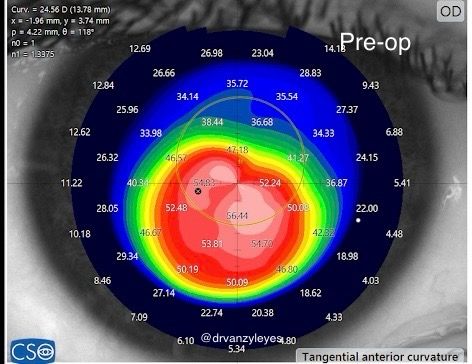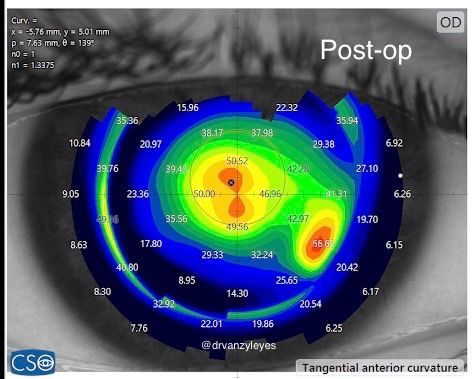Corneal Allogenic Intrastromal Ring Segments
(CAIRS)
CAIRS stands for
Corneal
Allogenic
Intrastromal
Ring
Segments. CAIRS is the latest surgical advancement in keratoconus care and is the most advanced corneal sparing operation for keratoconus.
I was the pioneering surgeon of CAIRS in Western Australia by being the first eye surgeon in Perth and the 3rd in Australia to perform this ground-breaking and corneal saving surgery.
I have performed the first and most amount of CAIRS procedures in WA.
With CAIRS, highly specialised, customised and accurate tunnels are created in the keratoconic cornea by the
Visumax 800 Femtosecond laser.
Prepared corneal transplant tissue in the shape of half circles are then placed in the prepared tunnels. I can also use the
Visumax 800 to create segments for CAIRS. Extra corneal tissue is thus added to the diseased keratoconic cornea.
The extra corneal transplant tissue works twofold:
- It flattens the steep cone and causes a regularisation of the keratoconic cornea
- It bulks up the thinned out part of the cornea that bulges in keratoconus
How is CAIRS performed?
Benefits of CAIRS:
A customised CAIRS segment in the left cornea. This patient is seeing 20/20 again after CAIRS. Prior to CAIRS he was only seeing 20/100 **
** Individual outcomes may differ
The preoperative corneal topography appearance of the eye prior to CAIRS. Note the central cornea is extremely irregular. The red area indicates a steep cornea due to a cone from keratoconus
The post-operative corneal topography appearance of the eye after CAIRS. Note the central cornea is significantly flattened and more regular. The red area indicates the CAIRS segment which is invisible for the patient

Another example of a patient who’s keratoconus was healed after CAIRS. Before the CAIRS procedure the patient’s best vision was 20/150. Post CAIRS the patient corrected to 20/20 again.**
** Individual results may vary and 20/20 vision post CAIRS is never promised or guaranteed


- CAIRS tunnels are created with the Visumax 800 Femtosecond laser at a precise angle and depth in the cornea
- The CAIRS laser tunnelling is completely painless and invisible to the patient
- The CAIRS tunnel is then expertly opened with specialised dissectors
- The specially prepared corneal tissue segment is carefully placed inside the tunnel
- The patient does not have to undergo a corneal transplant
- The patient is not dependent on steroids for the rest of their lives
- It has a greater effect than archaic plastic rings that are unfortunately still used by unsophisticated and untrained “corneal specialists” at other WA laser eye centres
- It is corneal tissue ring segments are biocompatible
- The corneal ring segments do not cause any scarring in the cornea
- The corneal tissue ring segments cannot protrude like plastic rings
- The whole procedure is reversable
- CAIRS is adjustable and reversible making it the safest corneal surgery there is
- The segments can be personalised to give a customised treatment
- CAIRS improves vision without glasses significantly
- CAIRS regularises and treat keratoconus to help patients see significantly better with glasses- many patients correct to 20/20 vision again
- PRK laser eye surgery and corneal collagen cross-linking can be performed on patients that have undergone CAIRS
- After CAIRS, vision can be further improved by performing topographical laser eye surgery
Frequently Asked Questions about CAIRS
If you are considering or been recommended CAIRS surgery, you probably have many questions.
Some of the most frequent ones are addressed here. This information is not intended to replace consultation with your eye surgeon.
Is tissue removed from my cornea during Femto-CAIRS?
No. In the contrary: the implanted corneal ring segment adds additional tissue to your cornea.
Who is a candidate for CAIRS if they have keratoconus?
Candidates for CAIRS typically have corneal steepness between 50 and 70 optical units and a minimum corneal stromal thickness of 300 micrometers. The expected outcome is a flattening of the cornea by five to more than ten optical units. The procedure also allows for the possibility of further corneal improvements through additional treatments, such as corneal collagen cross-linking or a Topography-guided Trans-PRK.
My keratoconus is progressive. Can I still have CAIRS?
Yes. Whether your cornea is progressive or stable is an issue that will be addressed with corneal cross-linking (CXL).
CAIRS has a completely different effect; it reshapes and stabilises the cornea for better vision. CAIRS can be used in both stable or progressive keratoconus. In the latter, it will be combined with CXL.
What else can be done after CAIRS to further improve vision?
CAIRS represents an approach in corneal treatment that combines the use of human corneal tissue with laser technology, aimed at addressing corneal irregularities with a focus on both safety and customization to each patient’s cornea by addressing the main complications of keratoconus namely, steepening and thinning of the cornea itself.
The beauty of CAIRS is that it adds additional tissue to the thin keratoconus cornea. In a next step, the cornea and the patient’s vision can be further improved with other treatments, such as corneal collagen cross-linking and/or Topography-guided Trans-PRK.
What is the cost of CAIRS?
The price of CAIRS depends on several factors, including the individual staging of the patient’s disease and whether one or two ring segments are necessary.
CAIRS is a complex procedure and involves detailed planning of the placement, length, and width of the ring segment, the preparation of the ring segment from a human donor cornea provided by an eye bank, the planning, calculation, positioning and creation of the corneal tunnel in the patient’s cornea, and implantation of the ring segment under intraoperative control of an optical coherence tomographer (OCT).
The total treatment time including calculation of the profile can take me and my team up to 3-4 hours. All these factors and the additional cost of a human cornea provided by an eye bank make the procedure considerably more costly than a ring implantation with a PMMA plastic ring segment.
CAIRS is not covered by the MBS and is a self-funded procedure. Total costs can vary between $4900 to $6900 per eye depending on the factors discussed above.
My Mission Statement:
I am dedicated to providing the best clinical expertise and the highest standard of care.
This is on a personal and professional level, to give all my patients of all ages the best opportunity for a lifetime of healthy eyes and excellent vision.
Over the past 20 years I have had the absolute pleasure of helping tens of thousands of patients of various ages improve and maintain their vision. Helping patients to free themselves from the burden of glasses and contact lenses is my passion.
To perform microsurgery on the eyes requires exceptional surgical skill and acumen. To perform all types of eye surgery and any other ocular surgery at a world class level requires expertise along with access to state of the art and the world’s best equipment. For this reason I have spent a total of 17 years training and perfecting my surgical armamentarium and spared no cent to acquire the best and most advanced diagnostic, surgical and laser equipment in the world to provide my patients with world class care.
I understand that getting surgery, especially on your eyes, is a serious decision and can cause anxiety in some. Your eyes are unique, and you should demand a bespoke solution tailored to your lifestyle, visual requirements and goals. That is why I offer the most thorough and intense medical examination and consultation that any patient will ever go through. During your consultation we will meet, and I can take the time to answer all your questions and talk through any concerns you have.
I am passionate about transforming people’s lives by transforming their vision. I look forward to spending time with you at our stunning and state of the art clinics in Booragoon and Craigie to see whether you could gain exceptional vision and eye health
MBChB, DipOphth, FCOphth, FRANZCO, MMed (Ophth), FRCSI, FEBO, GradDip(RefCatSurg), MMed(RefCatSurg), FWCRSVS

Why Choose Me?
More than 20 years of ophthalmological experience
Tens of thousands of satisfied patients
A professional team dedicated to the best outcome for your eyes
Exceptional reviews and word of mouth recommendations
Get in touch with my team
Whether you are ready to take the plunge into a world of crystal clear vision, or just have a few questions for me, feel free to drop me a line.
Own your Vision today!
.
Contact Us
We will get back to you as soon as possible.
Please try again later.
Happy Patients
I'm proud to have earned glowing reviews from patients who I've helped own their vision allowing them to enjoy a life free from the constraints of glasses and contact lenses. I'm humbled by the the overwhelming positive online reviews on Google.


All Rights Reserved | Lourens van Zyl




